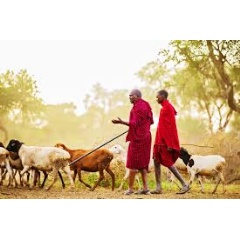Cross border disease outbreak simulation exercise reinforces preparedness in East Africa
Jackson Tipapa, a Kenyan cattle farmer from Loitokitok, explained the dire situation on his farm to a team of health and livestock experts. The 48-year old husband and father of four represented a distraught community whose cattle were dying. A strange disease was threatening further loss of their goats, sheep and what was left of his cows.
“The cattle are weak and ill with diarrhoea. Some have died while others have miscarried,” he told the visiting team. It was not just livestock that was affected. Some people in the community had fallen sick – with diarrhoea, high fever and vomiting.
Meanwhile, across the Tanzanian border in the town of Longido, another farmer explained a similar situation to a rapid response team of health experts and vets who were following up on an alert about the situation. They examined the animals and took dung and blood samples for testing while health workers engaged members of the community and answered questions about their concerns.
Fortunately for Jackson and neighbouring farmers, this scenario was part of a Field Simulation Exercise (FSX) that occurred in June 2019 at the Namanga One Stop Border Post (above) and the surrounding areas in both Kenya and Tanzania.
The exercise was convened by the East Africa Community (EAC) and implemented by the World Health Organization (WHO) to test both countries’ preparedness and response to disease outbreaks. It covered various real-life simulations involving the health, livestock, agriculture, tourism and environment sectors. The simulation that was presented was not unusual in the region, and highlighted the daily challenge of managing the risk of disease outbreaks.
The exercise scenario depicted a cross-border Rift Valley Fever (RVF)-like virus outbreak (a fictitious virus described as East Rift Fever was created so as not to interfere with current public health efforts targeting real viruses circulating in the region). The outbreak scenario impacted humans and animals, lives and livelihoods, agriculture, trade and tourism, peace and security and the overall regional economy.
In response to the need to prepare EAC Partner States for Ebola due to the ongoing outbreak in the Democratic Republic of the Congo (DRC), the fictitious exercise featured a RVF virus that mutated into a pathogen that could be transmitted between humans, causing a severe haemorrhagic fever that resulted in a high number of cases and deaths. This aspect of the simulation allowed for an assessment and strengthening of EAC capacities to prepare and respond to an Ebola-like situation using the One Health approach.
During the exercise, the rapid response teams acted on emergency alerts sent from a control room. The follow-up response was tested to examine how efficiently health and other emergency teams reacted.
Infections and deaths in animals and human beings triggered the activation of national and regional preparedness and response mechanisms emphasising the importance of the One Health approach and of appropriate risk communications and cross-border collaboration.
“Every possible element of the system is tested to examine preparedness for any public health outbreak,” said Frederik Copper, WHO Exercise Coordinator.
The exercises were carried out in real-life settings to determine the level of preparedness and to assess operational capabilities at regional and national levels. The exercises focused on strengths and weaknesses in coordination and collaboration mechanisms, emergency response deployment, logistics and administrative processes, risk communication and emergency management and leadership.
The scope and complexity of the exercise drew the attention of other members of the EAC. Burundi, Rwanda, Uganda, South Sudan and other countries from the World Health Organization (WHO) Africa Region acted as observers to the process.
Convened by the EAC Secretariat, the exercise involved 150 experts from Tanzania and Kenya in 23 exercise locations. WHO was the lead technical agency responsible for developing, designing and coordinating the exercise, with financial support from the Government of Germany.
The simulation identified clear strengths, including functional multi-sectoral collaboration; the effective use of the One Health approach; rapid response to alerts and deployment by some rapid response teams; and functional use and activations of standard operating procedures and guidelines.
The exercise was not only intended to identify achievements and challenges in preparedness and response for a public health event affecting the East African Community, but also, by exposing participants to a realistic scenario, and to practise the roles they would carry out in a real emergency.
“The findings from the Field Simulation Exercise will be used to further enhance preparedness and response capacities in the EAC region and beyond,” said Christophe Bazivamo, EAC Deputy Secretary General. He noted that the effort by the EAC countries and partners was timely given the Ebola epidemic in the DRC, which shares a border with five member countries.
While the ongoing Ebola outbreak in the DRC has captured world attention, the threat of future epidemics and public health emergencies remains acute in the African region. WHO reports that all 47 countries in the region are at risk of health security threats and more than 150 acute public health events strike the region annually.
The success of this WHO-led simulation exercise will be measured by the effectiveness of early warning and detection practices at points of entry. The outcomes of this exercise will help Kenya and Tanzania work together with the EAC and partners to build and maintain resilient national health systems, which can respond effectively to health emergencies. This exercise will also provide an example that other countries can consider their own preparedness and response to disease outbreaks and natural disasters.
( Press Release Image: https://photos.webwire.com/prmedia/6/245097/245097-1.jpg )
WebWireID245097
This news content was configured by WebWire editorial staff. Linking is permitted.
News Release Distribution and Press Release Distribution Services Provided by WebWire.
